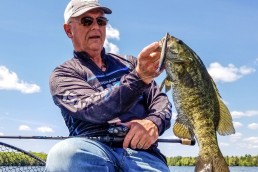Jerkbait Jargon
SHARE THIS POST
Joe Bucher discusses when, where and how to fish jerkbaits for bass.
Bummer! A major weather change really shut down my killer crankbait pattern. Yesterday, skies were relatively clear, the sun shone brightly, and a southerly breeze slapped white-capped waves into the rocks. Today is completely the opposite in nearly all aspects. Thick gray clouds, a dark overcast along with northerly winds and a relatively calm shoreline give me the sense I am now fishing a completely different lake. Did these bass move out, or do I simply need to change up tactics?
Reluctantly, I put down my crankin’ sticks and rig up several rods with various suspender-style, minnow-shaped lures, commonly called jerkbaits by the bass world and begin fancasting around the same general area that produced recently. Almost immediately, I am back on a hot bite!
This tactical shift most often yields big-time results. Wave action, along with bright sun, generally pushes bass tighter to bottom where they tend to hunker next to various forms of cover, ready to ambush crawdads and baitfish traveling close by. Bouncing, bumping and grinding deep-diving crankbaits along the bottom attracts a lot of bass attention in this situation.
A lack of wave action and no current encourages bass, as well as baitfish, to leave cover and hover off-bottom where they tend to freely roam both inwards and outwards in search of prey. Generally, cranks fail to consistently connect with bass in calmer waters because they run too deep and track underneath the vast majority of bass suspended off bottom. Plus, calm-water-suspended bass tend to be less aggressive overall and less willing to bolt after faster prey. Instead, a struggling minnow-shaped prey darting a short distance and suddenly pausing in place or slowly rising in an injured manner offers up an irresistible opportunity.
Control your cadence
Find out what retrieve cadence bass respond to best. The pace of your retrieve along with the length of pauses between jerks is sure to vary a lot. Generally, the colder the water, the longer the pause.
Also, experiment with various colors in order to determine if any pattern preferences exist. In most cases, one color is sure to work better than others. Testing various patterns over a good spot is the only way to know for sure which one is best at any given time.
Are you enjoying this post?
You can be among the first to get the latest info on where to go, what to use and how to use it!
The whole science of jerkbait fishing can be broken down even further in an effort to discover the very best producing variables. For example, minnow baits themselves come in three different versions: floating, sinking, and suspending. The most productive version is sure to vary with conditions. Experimenting with various versions and different tackle matchups is the only way to know for sure which one is best at any given time.
When to float and when to sink
The type of line you use, as well as its diameter, can also have a major impact on a jerkbait’s buoyancy and action. For example, a floating line, such as monofilament or braid, is generally desired for shallow waters and topwater fishing classic floater jerkbaits. Cast this same lure with a sinking line, like fluorocarbon, and that same floater will rise much slower or might even suspend. In fact, casting the same lure with a thinner-gauge, 8-pound-test fluorocarbon versus 12- to 15-pound is almost guaranteed to get drastically different results.
Don’t be surprised if a floater suddenly becomes a sinker simply due to line test and texture. This is why tackle matchup considerations are important to your success. One can also subtly or drastically affect the buoyancy and action of any given jerkbait by changing out hook sizes and weights. Generally speaking, larger or heavier-gauge hooks make the lure less buoyant and tighten up the wobble. With this in mind, one can alter the hardware on a favorite jerkbait minnow and the tackle used in order to achieve a specific result.
Jerkbaits should be a big part of any bass angler’s arsenal. They are sure to catch some bass in all kinds of conditions, and really shine when bass are sluggish. Take the time to master this magnificent lure group. Once you do, big fish photos will be coming your way!
Even seasoned outdoorsmen can learn helpful new methods in the May issue of MidWest Outdoors, available the first full week of May at the newsstand or by subscribing on our website.
MWO
SHARE THIS POST
You may also like...
Nothing found.
Did you enjoy this post?
You can be among the first to get the latest info on where to go, what to use and how to use it!
Joe Bucher
Joe Bucher is a Freshwater Fishing Hall of Fame Legendary Angler, book author, lure designer and host of Fishing with Joe Bucher TV series.
